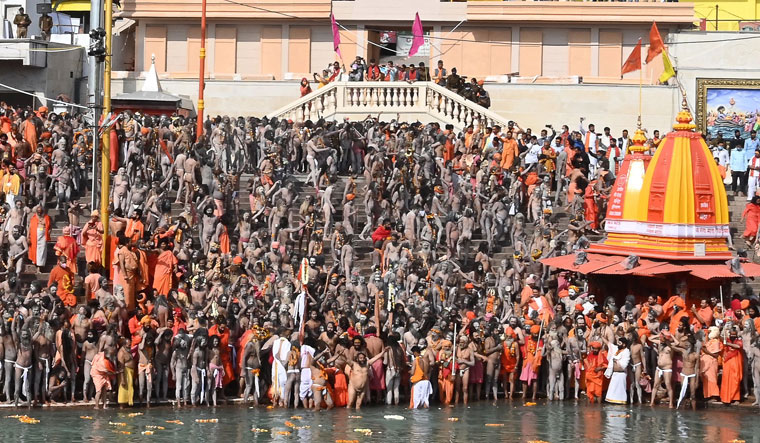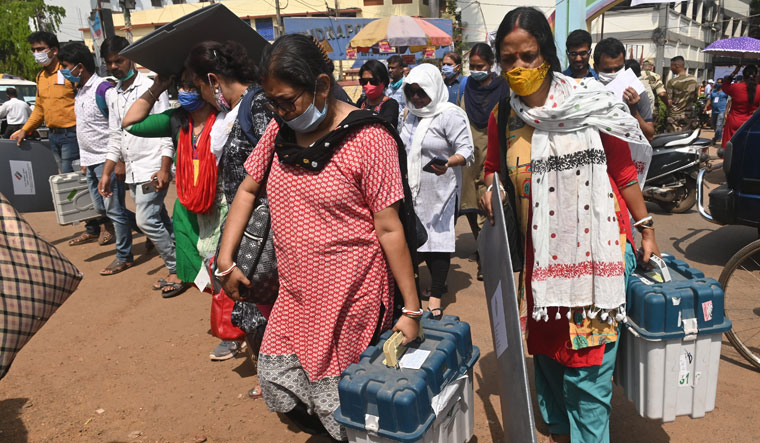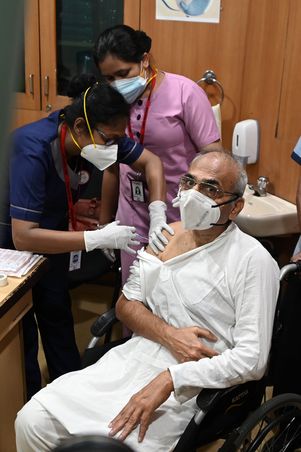The warnings had been there—loud, clear, and writ in print. Not just from doomsayers in cyberspace and the Cassandras in distant laboratories, but from revered institutions of governance within India. Cautioning that the country was poised for a nasty second wave of Covid-19, some of them had even listed what needed to be done to save lives. Sadly, the warnings fell on ears deafened by the din of mutual back-patting, hasty claims of victory over the pandemic, misplaced confidence in systemic self-reliance, and boastful assertions that India had become the world’s vaccinator.
Perhaps the most authoritative warning came on November 25, when a parliamentary standing committee headed by Ram Gopal Yadav of the Samajwadi Party, and comprising members of ruling and opposition parties, submitted a report that asked the government to “be prepared to combat a possible second wave... especially in the ensuing winter season and the super-spreading series of festive events”. The wave arrived later than expected, yet it caught the government abysmally unprepared.
The committee had also identified the challenges India faced and assessed the readiness of its health care system. And it made a slew of recommendations to the government: boost the production of oxygen immediately, regulate prices of cylinders and Covid drugs, make hospital beds available, ramp up vaccine production and supply, and administer doses to the poor at subsidised rates. The report today reads like an assessment of everything that has gone wrong with India’s Covid management.
It was not a politically loaded report, but a bipartisan one that had been prepared after days of hearing more than three dozen of India’s topmost scientists, doctors, health administrators and think-tanks. Among those the committee heard were the top brass of the Indian Council of Medical Research, the All India Institute of Medical Sciences, various departments of the health and AYUSH ministries, and think-tanks such as the Public Health Research Institute.
The committee had noted that oxygen production in India was about 6,900 tonnes a day, and that the demand from hospitals alone had reached 3,000 tonnes a day by the end of September. It had asked the government to make a national oxygen inventory, and urged the National Pharmaceutical Pricing Authority to fix prices.
By then, the government had begun making moves. Even as early as the first lockdown last year, an empowered group headed by NITI Aayog CEO Amitabh Kant had warned that “India could face a shortage of oxygen” and suggested that the Confederation of Indian Industry “coordinate with the Indian Gas Association and mitigate the lack of oxygen supply”. A committee headed by Guruprasad Mohapatra, secretary in the department for promotion of industry and internal trade, was set up to “ensure adequate availability of medical oxygen”. And, as early as April 7 last year, the drug controller-general had allowed licences to be issued to industrial gas manufacturers to make medical oxygen on 24-hour notice.
In October, the government announced Rs2,000 crore to set up 162 oxygen generating units in 150 district hospitals across India. Most state governments prepared to set up plants, but only 33 such units had been installed by April this year. Also, as home ministry officials admit, the Essential Commodities Act is yet to be invoked against hoarding or black-marketing of oxygen or essential drugs.
As it turned out, oxygen supplies began to be mapped only by mid-April this year—that, too, at the Supreme Court’s instance. This and other measures, such as curtailing oxygen for industrial purposes, had added 1,000MT to the oxygen stock. But all this came too late—thousands of people across the country had begun gasping for air.
Meanwhile, the vaccine story was turning out to be a tragicomedy of sorts. When the parliamentary committee was preparing its report, vaccines were still on trial phase. But most of the experts had told the committee that India’s production capacity was inadequate. This had prompted the committee to ask the government to ramp up capacity and find ways of subsidising vaccines for the poor. It had also recommended that the government adopt a “multi-tiered, risk-based approach” for vaccination.
Other experts, too, had urged the government to prepare a vaccine plan—especially since it faced the twin challenges of supplying vaccines to the world and inoculating the world’s second largest populace. In fact, a research paper published by community health experts Indrani Gupta and Rama Baru in the Indian Journal of Medical Research last year had even advocated for a white paper on the vaccine procurement plan, asking “what role will the private sector play in vaccine supply, and to what extent will the government be willing and able to regulate the price and quantity of vaccines that would be available with the private sector?”
Forget the white paper, it appears the government woke up only after the vaccines began rolling out from the plants. No firm orders had been given to the Serum Institute (which makes Covishield on licence from abroad) or to Bharat Biotech (which makes the home-grown Covaxin). The first order was placed only on January 11 this year, five days before the actual launch of the vaccination drive. And even that was for just 16 million doses, while the monthly requirement was 180 million.
The first payment—of Rs4,500 crore—went to the vaccine-makers only in April. As vaccine expert Gagandeep Kang pointed out, the government may have given financial aid to the manufacturers, but had not placed advance orders. Obviously, without domestic orders coming, the manufacturers had to secure orders from abroad. That there had been no vaccine plan, despite the advice from experts and the parliament committee, became all the more evident when the government opened up vaccination to the 18-plus age group without having inoculated even a tenth of the population aged 40 and above.
The shortage of hospital beds, apparently, has more to do with the state governments. The Centre had claimed before the parliament committee that the main purpose of last year’s lockdown was to slow down the spread and gain time to ramp up health care capacities. Indeed, capacities were ramped up—3,914 treatment centres were set up with 3,77,737 isolation beds, 39,820 ICU beds, 1,42,415 oxygen-supported beds and 20,047 ventilators. The number of isolation beds was up by 34 times, ICUs by 20 times, and patient handling capacity by 35 times.
But as winter passed uneventfully, with daily cases dropping and the government claiming victory over Covid, most of the infrastructure was dismantled. Contractual staff were sent away and inventories were ignored. For instance, the 10,000-bed makeshift hospital in Delhi’s Chhattarpur, run by the Indo-Tibetan Border Police, and the Defence Research and Development Organisation’s Sardar Vallabhbhai Patel Hospital in Delhi Cantonment were dismantled in February, after the number of cases came down from the peak of 8,500 in November. But by April, not only were these hospitals back, but there was a scramble as well to set up a 500-bed ICU facility at Ramlila Ground.
Home ministry officials admit that the government, which had been a control freak throughout last year, had left its own departments—and states, drug-makers, vaccine-makers and the people—to fend for themselves. “No quarter was given to the states in the case of the thrice-extended lockdown, which was fine,” said an official. “Where it erred was in enforcing the unlock orders with the same sternness as the lockdown orders.”
By September, the process of phased reopening had started, and some of the states wanted to extend the lockdown. But the national executive committee chaired by Union home secretary A.K. Bhalla—which under the National Disaster Management Act was empowered to plan, coordinate and monitor mitigation efforts—forbade the states from imposing local lockdowns without consulting the Union government. “State/UT Governments shall not impose any local lockdown (State/District/sub-division/City/village level), outside the containment zones, without prior consultation with the Central government,” Bhalla told chief secretaries.
With the Centre deciding virtually everything, and often not sharing the rationale of its decisions, the states abandoned most of their planning processes. “The wheels of the state administration do not turn overnight,” explained a Delhi state official. “First, the lockdowns were sudden, catching the states unprepared. By the time they were managing containment zones as per the [Union home ministry] guidelines, it was time to unlock.”
There are many who believe that leaving matters to the states could also have backfired. For instance, in Maharashtra, which today accounts for a fifth of India’s Covid patients and a third of Covid deaths, the government was so focused on saving Mumbai that it allegedly ignored the rest of the state. Anyway, the Union government had started hastily celebrating the defeat of Covid.
Political priorities, too, had changed—for assembly polls in five states were round the corner. “The political leadership took the lead in claiming premature victory,” said the official, pointing out the prime minister’s claim at the World Economic Forum’s Davos Dialogue that India had taken “a proactive public participation approach and developed a Covid-specific health infrastructure”.
Throwing all caution to wind, the government not just opened up the economy but allowed super-spreader events like multi-phased assembly polls and a Kumbh Mela. “The Kumbh, which is held every twelve years, was supposed to take place in 2022,” said former home secretary G.K. Pillai. “Instead of postponing it, why was it advanced during the pandemic?”
But the Uttar Pradesh administration maintains that the event adhered to all the rules. For one, the four-month event was cut short to one month, and only about 25,000 people took the holy dip. “All possible measures were taken by the government to contain the spread of Covid-19,” said the government’s mela officer Deepak Rawat.
Said Rashmi Kumari, assistant professor at Ram Manohar Lohia Institute of Medical Sciences, Lucknow: “There are many elements of the virus which we still do not understand, including the modes of its transport. Religious gatherings are by nature very difficult to regulate.”
Pillai criticised the Election Commission for spreading the election in West Bengal over a month in eight phases. “When Tamil Nadu, which is also a large state, could have polls in one phase, why couldn’t West Bengal? Adequate deployment of Central paramilitary forces by the Union home ministry could have made it possible," he said.
The Election Commission said it could only fix the norms for gatherings. “We came out with the first set of guidelines for elections during Covid-19 in August 2020,” said a commission officer. “District magistrates and superintendents of police were asked to brief us about grounds in each district that had adequate space. We consulted the parties while preparing the guidelines. We cannot micromanage everything from here. We cannot be expected to [visit] every ground and ensure compliance.”
Major Gen (retd) Anil Verma of the Association for Democratic Reforms, however, said the commission should have been more proactive. “It stayed aloof,” he said. “Maybe it was because of rallies being held by some weighty people.”
Pillai agreed. “When the political class gets busy with politics, it is the well-oiled administrative machinery run by bureaucrats that ought to carry on,” he said.
Independent experts blame a combination of factors for the Covid crisis. There was “complacency and negligence on the part of citizens; and a declaration of victory against the virus led to further complacency,” said Dr H. Sudarshan Ballal, chairman of Manipal Hospitals, Bengaluru. “Allowing huge election rallies, religious events and protests added to the super-spread of the virus. The new mutants added to the spread; they seem to be extremely infectious compared with the previous variety.”
with Rekha Dixit, Soni Mishra, Puja Awasthi, Pooja Biraia Jaiswal and Mini P. Thomas





